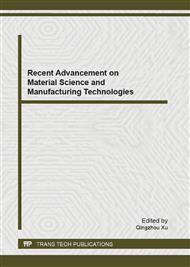[1]
Q. M. Zhang, H.F. Li, M. Poh, H.S. Xu, Z.Y. Cheng, F. Xia, C. Huang, An all-organic composite actuator material with a high dielectric constant,Nature vol.419(2002)284-287.
DOI: 10.1038/nature01021
Google Scholar
[2]
V. Panwar, J. O. Park, S. H. Park, S.Kumar, R. M. Mehra, Electrical, dielectric, and electromagnetic shielding properties of polypropylene-graphite composites, J. Appl. Polym. Sci.115 (2010), 1306-1314.
DOI: 10.1002/app.29702
Google Scholar
[3]
Z. M. Dang, Y. Q. Lin, H. P. Xu, C. Y. Shi, S. T. Li, J. Bai, Fabrication and Dielectric Characterization of Advanced BaTiO3/Polyimide Nanocomposite Films with High Thermal Stability,Adv. Funct. Mater. 18(2008) 1509–1517.
DOI: 10.1002/adfm.200701077
Google Scholar
[4]
W. Li, L. Yu, Y. Zhu, D. Hua, External Magnetic Field Induced Percolation in Polyvinylidene Fluoride and Nickel Composites , J. Phys. Chem. C 114(2010) 14004–14007
DOI: 10.1021/jp103086y
Google Scholar
[5]
S.H. Yao, Z. M. Dang, H. P. Xu, M. J. Jiang, J. Bai, Exploration of dielectric constant dependence on evolution of microstructure in nanotube/ferroelectric polymer nanocomposites, Appl. Phys. Lett. 92(2008) 082902-082904
DOI: 10.1063/1.2870104
Google Scholar
[6]
L. Yu, W. Li, Stretching induced percolation in polyvinylidene fluoride and nickel composites, J. Appl. Polym. Sci. 120 (2011)2368–2373
DOI: 10.1002/app.33430
Google Scholar
[7]
Z. M. Dang, L. Wang, Y. Yin, Q. Zhang, Q. Q. Lei, Giant Dielectric Permittivities in Functionalized Carbon-Nanotube/ Electroactive-Polymer Nanocomposites, Adv. Mater. 19(2007) 852-857.
DOI: 10.1002/adma.200600703
Google Scholar
[8]
R. P. Bagwe, L. R. Hilliard, W. Tan, Surface modification of silica nanoparticles to reduce aggregation and nonspecific binding. Langmuir 22(2006) 4357-4362.
DOI: 10.1021/la052797j
Google Scholar
[9]
D. Lairez, J. R. Emery, D. Durand, R. A. Pethrick, Dielectric study of epoxy vitrification: does a percolation model apply? Macromolecules 25(1992) 7208–7210
DOI: 10.1021/ma00052a022
Google Scholar
[10]
D. M. Grannan, J. C. Garland, D. B. Tanner, Critical behavior of the dielectric constant of a random composite near the percolation threshold. Phys. Rev. Lett. 46(1981) 375–378.
DOI: 10.1103/physrevlett.46.375
Google Scholar


